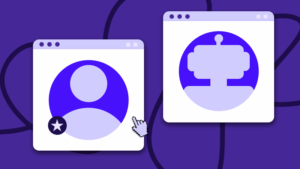How to Create a UGC Portfolio: Examples & Step-by-Step Guide
With over 7 years of e-commerce experience, Agne has mastered the balance of creativity and performance. From guiding social media strategies to crafting high-converting ads, she’s all about results.
After a five-year stint in corporate marketing in California, Lucas decided to hang up the suit and tie for a more relaxed setting. He moved to Barcelona to get his MBA and enjoy the Mediterranean lifestyle. After spending 15 months in Europe, Lucas moved back home to Reno, Nevada where he started his own digital marketing company, StratMark. When he is not working, Lucas is out skiing, rock climbing, mountain biking, and just enjoying the outdoors.

A user-generated content (UGC) portfolio is more than a collection of your work. It’s an opportunity to showcase your unique style and personality and to show your ability to create content that resonates with your audience.
As a UGC creator, your portfolio is your calling card, and it’s essential to get it right. In this article, we’ll show you how to create a UGC portfolio that stands out from the crowd and attracts the attention of brands and businesses.
We’ll also cover choosing the right platform, what to include in your UGC portfolio, and what to leave out. And finally, we will cover some things you can do to kickstart your exposure to brands and widen your audience.
Understanding UGC Portfolios
So, what exactly are UGC portfolios, and why do they matter?
A UGC portfolio is an important asset that showcases your best work. It is not just a collection of projects, but a representation of your skills, style, and authenticity.

It is typically hosted as a web page or folder that can be shared via a link with potential clients.
A portfolio is an important step in building trust and demonstrating social proof to potential clients. It highlights your professionalism and credibility.
It also serves as a self-marketing tool, allowing you to target specific industries or brands, and continuously evolve your content to reflect growth and new trends.
By showcasing your range of work and creative flair, your UGC portfolio gives you a competitive edge. It will boost your client’s confidence and be instrumental in advancing your career in content creation.
UGC Portfolio Examples
UGC portfolios come in different shapes and sizes, but they all serve the same purpose. They allow potential clients to see the type of UGC you create and what they can expect from working with you.
Here are some UGC portfolios that do a great job of resonating with their audiences.
Remember, keep an open mind and a keen eye for innovative approaches and creative presentations. These examples will serve as your guide, showing you how to craft a UGC portfolio that leaves a lasting impression.
Ruby Yeo
Portfolio: ugcbyruby.my.canva.site
Tool: Canva

Ruby’s portfolio on her Canva site demonstrates a keen eye for detail and a talent for creating visually appealing UGC. She does a great job of showing her previous partnership front and center. This is a great way to show social proof and gain trust with potential brands.
Kaylee Kwa
Portfolio: kayleekwa.my.canva.site
Tool: Canva

Kaylee’s portfolio showcases a blend of creative and engaging UGC, particularly on platforms like TikTok and Instagram. Her content is well-organized and categorized, making it easy for visitors to navigate and appreciate her work.
Joshie Houlahan
Portfolio: ugcjoshie.com
Tool: Canva

Joshie’s portfolio showcases his skills in creating visually appealing videos that align with the brand’s ideals and the quality of products presented. He works with various brands, ranging from fashion to grooming and accessories, and his portfolio reflects his unique blend of Indian and Australian heritage, offering a unique perspective in his content creation.
His portfolio is also built on Canva, but Joshie uses a custom domain to add a layer of personalization and make it easier for people to find his portfolio.
Scotty
Portfolio: createdbyscotty.com
Tool: Squarespace

Scotty, an Australian UGC creator, specializes in direct response marketing strategy and content that converts. With over nine years of experience, he has worked with major brands in tourism, lifestyle, SaaS, and e-commerce.
His portfolio includes a range of UGC services for photo and video content, designed to build trust and engagement across platforms like TikTok, Instagram, and Facebook.
How to Create Your UGC Portfolio?
When creating your UGC portfolio, it is important to keep in mind that it should be visually appealing, easy to navigate, and showcase your best work. Use high-quality images and videos to show your skills and style. Make sure to include a brief bio and contact information so potential clients can easily reach out to you.
Creating a UGC portfolio may seem like a lot of work, but fear not; we’ve broken it down into a step-by-step guide that simplifies the process.
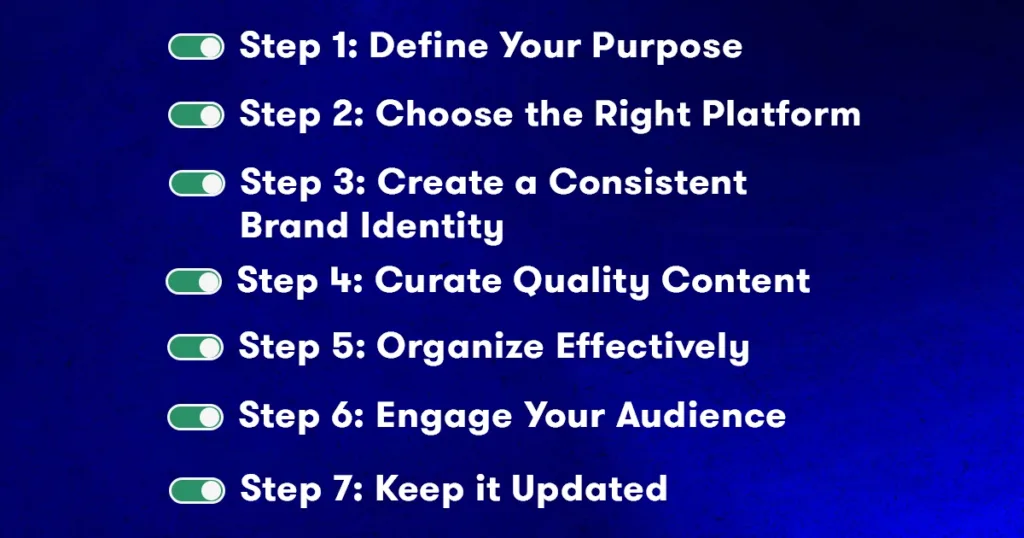
Step 1: Define Your Purpose
Begin by clarifying your objectives. Are you a seasoned UGC creator aiming to showcase your skills and attract a larger and more diverse clientele? Or are you a new UGC creator looking to expand and connect with your audience on a deeper level? Defining your purpose will guide the content you collect and curate.
Step 2: Choose the Right Platform
Selecting the right platform to host your UGC portfolio is crucial. Explore options like personal websites, social media, or specialized portfolio platforms. Each has its advantages, so consider your target audience and your content’s nature.
- Canva stands out for its unparalleled versatility in graphic design. It provides creators with a canvas to craft stunning visual portfolios effortlessly. With a vast array of customizable templates, Canva caters to users seeking polished and visually captivating UGC portfolios.
- Adobe Portfolio seamlessly integrates with Adobe Creative Cloud, offering creators a synergy of tools. This platform is a haven for design professionals who seek a harmonious blend of creativity and professionalism in their UGC portfolios.
- Wix is synonymous with user-friendliness, thanks to its drag-and-drop functionality. It empowers creators to shape personalized UGC portfolios with ease. Wix’s extensive template library and customization options make it a prime choice for those who cherish creative control.
- Squarespace boasts a reputation for elegant aesthetics and user-friendly templates. It’s the go-to platform for creators who desire a polished and professional presentation of their UGC content. Squarespace helps turn your portfolio into a visual masterpiece.
- Behance shines as a global stage for creative professionals. It’s a launchpad for creatives seeking exposure and connections worldwide. With its far-reaching audience, Behance is a must for those aiming to elevate their UGC portfolios to international recognition.
- WordPress has unrivaled versatility that sets it apart as a dominant content management system. It caters to both beginners and seasoned users with its extensive theme and plugin options, providing limitless potential for UGC portfolio customization.
Step 3: Create a Consistent Brand Identity
Ensure that your portfolio aligns with your personal or brand identity. Consistency in design, colors, and messaging helps create a memorable and professional image.
Step 4: Curate Quality Content
The heart of your UGC portfolio is the content itself. Curate high-quality UGC that resonates with your audience. Include testimonials, reviews, images, and stories that showcase positive experiences and authenticity.
Step 5: Organize Effectively
Structure your portfolio in a user-friendly way. Use categories or sections to organize your content logically. A well-organized portfolio makes navigation seamless and keeps visitors engaged.
Step 6: Engage Your Audience
Encourage your audience to interact with your portfolio. Include calls to action (CTAs) that invite them to explore more of your content, follow you on social media, or share their own experiences.
Step 7: Keep it Updated
Your UGC portfolio is a living entity. Regularly update it with fresh content and reviews to reflect the evolving nature of your work.
What to Include in a UGC Portfolio?
Here are some essential inclusions for a successful UGC portfolio:
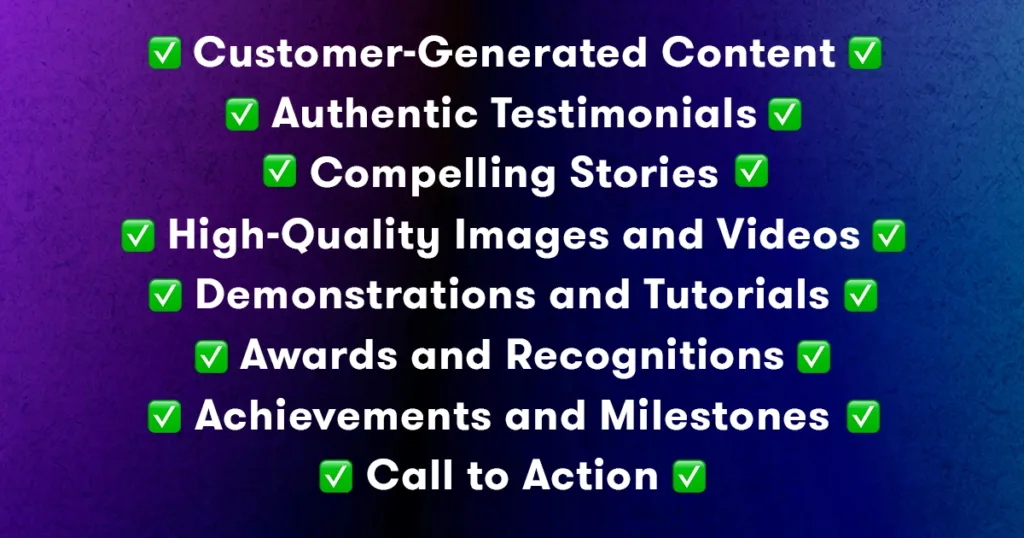
- Customer-Generated Content: The first thing you should include is the UGC that you have already produced. This can provide valuable insights into how you work with brands and how your work is perceived by your audience. Another important aspect of UGC that you should include is any content that your audience creates as a result of your original content UGC. This is a creative way to show potential clients that your audience is engaged with your content.
- Authentic Testimonials: Reviews and testimonials from satisfied customers or collaborators add credibility to your portfolio. Share the experiences of others to build trust.
- Compelling Stories: Stories are powerful tools for engagement. Include user stories that highlight the impact of your work on individuals.
- High-Quality Images and Videos: Visual content is eye-catching and memorable. Incorporate images and videos that showcase your work or product in action.
- Demonstrations and Tutorials: If applicable, offer demonstrations or tutorials that showcase your expertise. Show how others can benefit from your knowledge or products.
- Awards and Recognitions: Highlight any awards, accolades, or recognition your work or brand has received. These serve as endorsements of your quality.
- Achievements and Milestones: Showcase your journey by sharing milestones and achievements. It gives your audience a sense of your growth and dedication.
- Call to Action: Include CTAs that guide visitors to take action. This could include contacting you, making a purchase, or subscribing to your content.
- Domain Name: If you have chosen to host your UGC portfolio via a website then having a unique domain can make it easier for clients and brands to find you. Make sure to choose a domain name that is easy to remember and reflects your brand. You can explore domain options tailored to your industry to find the perfect fit for your business.
Remember, your UGC portfolio should be a reflection of your unique identity and goals. Tailor the content you include to align with your objectives and engage your audience effectively.
What Not To Include in Your UGC Content Portfolio
As you work on building your UGC portfolio, it’s equally important to be mindful of what you should avoid. Avoiding certain pitfalls can ensure that your portfolio remains effective and impactful.
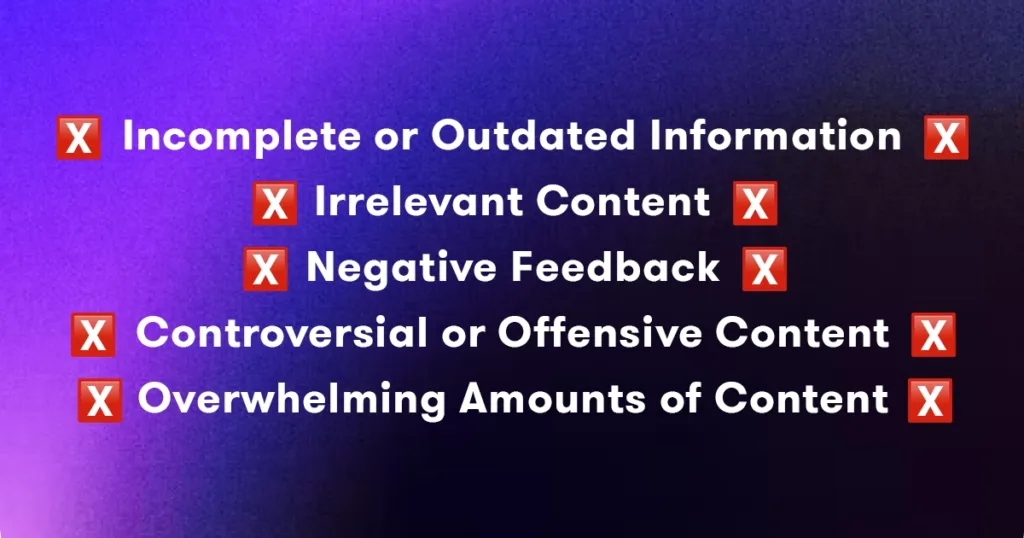
- Negative Feedback: While constructive criticism can be valuable, avoid showcasing overwhelmingly negative feedback. Focus on the positive aspects to build a favorable impression.
- Irrelevant Content: Keep your portfolio focused on your objectives. Exclude content that doesn’t align with your brand or goals.
- Incomplete or Outdated Information: Ensure that all the content in your portfolio is current and relevant. Remove outdated information that no longer serves your purpose.
- Controversial or Offensive Content: Avoid including content that may be controversial or offensive to your audience. Maintain a respectful and inclusive tone.
- Overwhelming Amounts of Content: While variety is important, don’t overwhelm your portfolio with an excessive amount of content. Quality should always take precedence over quantity.
Creating Your First Portfolio With Canva
Below are step-by-step instructions on how to create your first portfolio using Canva.
Step 1: Sign Up or Log In to Canva
- If you still need to get a Canva account, go to Canva’s website and sign up for free.
- If you already have an account, just log in.
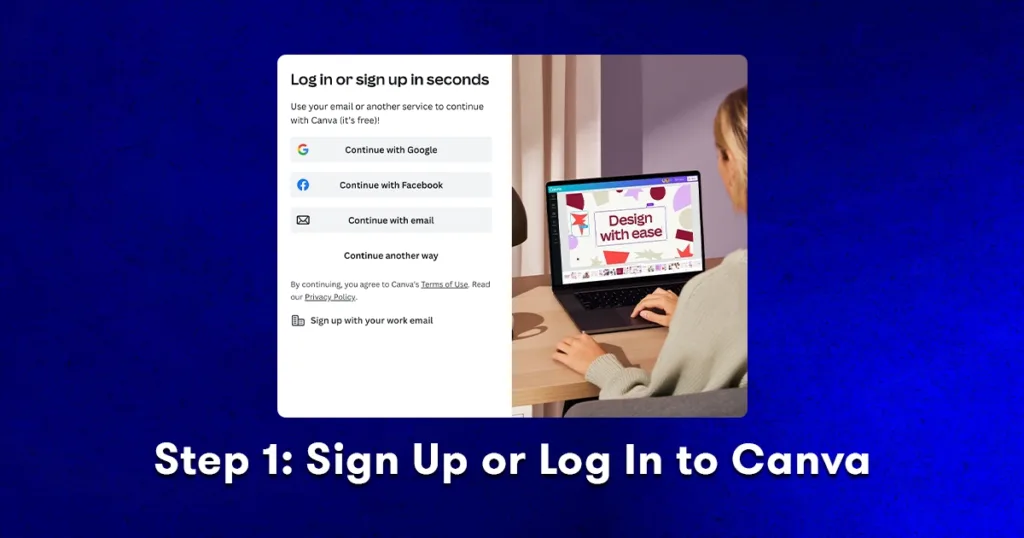
Step 2: Choose a Portfolio Template
- Once logged in, click the “Create a design” button and type “Portfolio” in the search bar, and choose “Online Portfolio”.
- Browse through the portfolio templates on the left-hand side and choose one that best suits your style and needs.
- You can always edit certain elements of a template if you don’t like them.
- Also, if you’re up to the challenge you can always create your template from scratch.
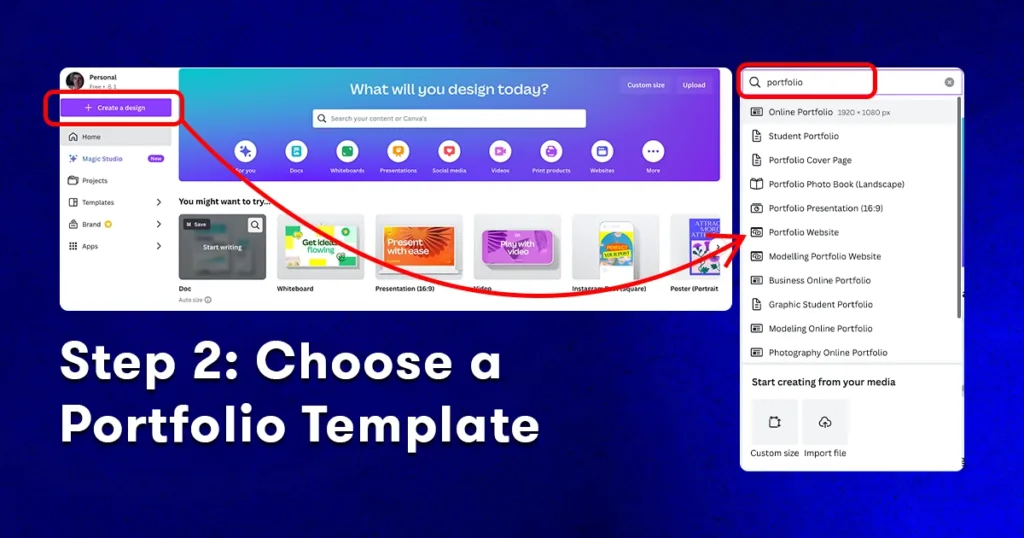
Step 3: Customize Your Template
- Replace the default text with your information. Include your name, a brief introduction, and contact details.
- To add text, click on the text box and start typing. You can change the font, size, and color to match your style.
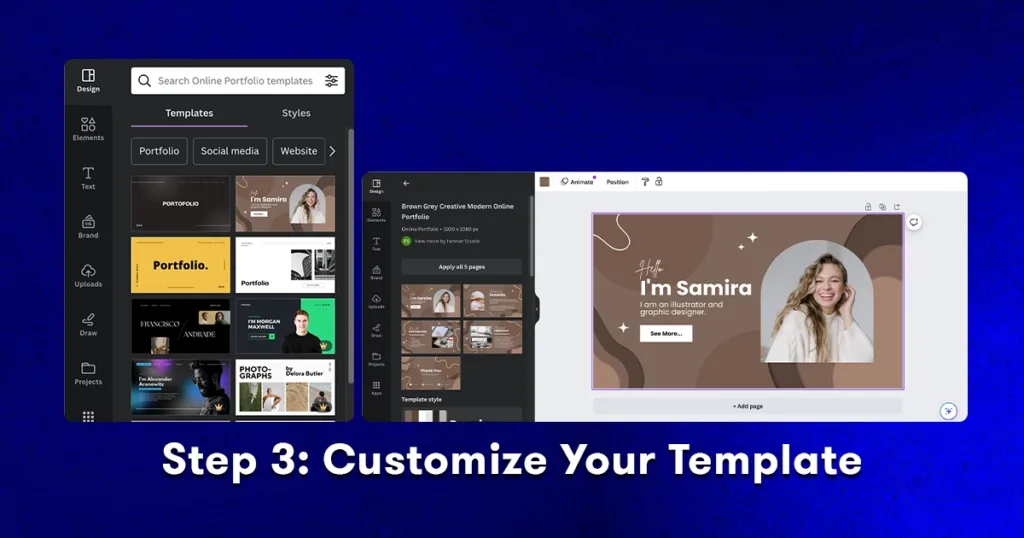
Step 4: Adding Additional Pages
- Canva uses a page system so when you want to add another section to your portfolio, you can do this by clicking the “+” button near the page navigation at the bottom. This will add another page or section for you to continue creating. Don’t worry about the pages not being together. In the end, you can convert it to a website to share and all your pages come together to look like a website.
- Don’t forget, you may need to add more pages later on.

Step 5: Add Your UGC Content
- Click on the “Uploads” tab on the left side and upload your UGC images or videos.
- Drag and drop your uploaded content into the template. You can resize and position them as needed.
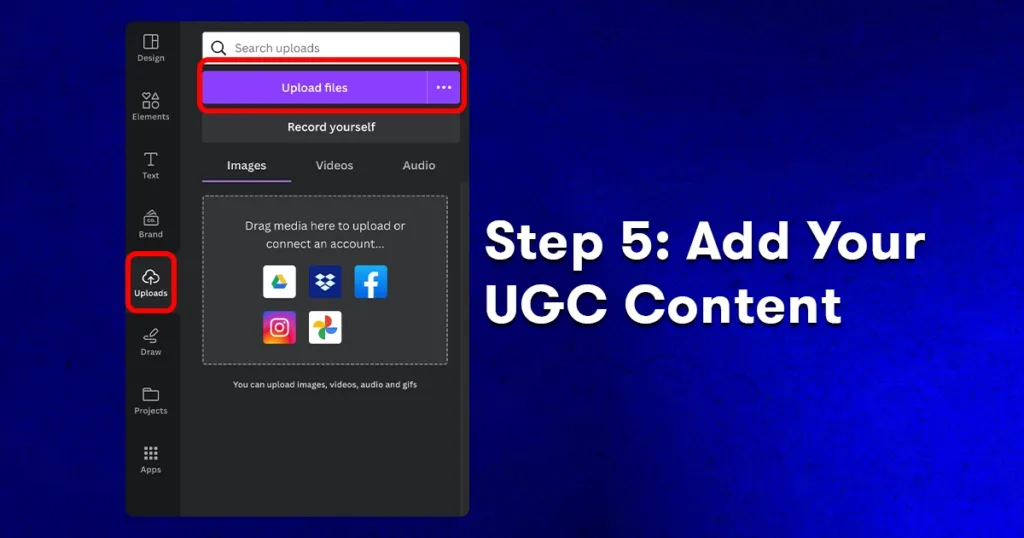
Step 6: Organize Your Work
- Arrange your UGC content in a way that is easy to navigate. Consider categorizing your work by project, client, or type of content.
- Make sure each piece of content has a brief description or title.
- Canva has great frames in which you can put your UGC content. If you want your content to look like it is playing on a phone screen, go to “Elements” on the left side of the screen and search “phone”. Place the phone frame on your page, then place your UGC content inside of it.
Step 7: Personalize Your Design
- Add elements that reflect your brand. This could be a specific color scheme, fonts, or design elements.
- Canva offers a variety of design elements like icons, shapes, and lines that you can use to enhance your portfolio.
Step 8: Review and Edit
- Go through your portfolio and make sure everything is correctly positioned, and there are no typos or errors.
- Ensure that your portfolio reflects your best work and is representative of your skills.
Step 9: Share Your Portfolio
- Once you’re satisfied with your portfolio, you can share your portfolio online directly from Canva by clicking the ‘Share’ button.
- You can create a “Public Link”. This will create a link that you can use to share your UGC portfolio in page form. This means that a person will be able to see each page individually.
- Alternatively, once you click the “Share” button, you can choose “Website”. This feature will allow you to convert your Canva pages into a one-page website.
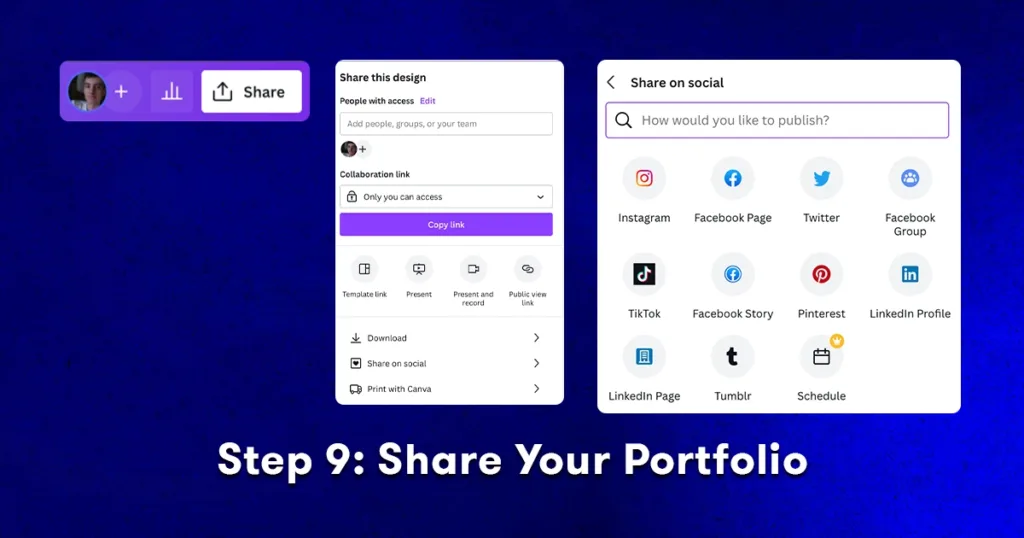
Step 10: Update Regularly
- Keep your portfolio updated with new content as you create it. This will keep it fresh and relevant.
Connecting with Clients and Brands
Once you have created your UGC portfolio, it’s time to start connecting with clients and brands. Utilizing platforms like Billo and other social media channels can kickstart your reach quickly.
In addition, understanding the importance of pitching yourself and collaborating with other creators can help you gain traction as a UGC creator.
Billo
Billo offers access to a diverse array of brands. This broadens the scope of your potential collaborations. It also helps diversify your portfolio with various types of content.
This exposure is crucial. It increases your visibility to brands actively seeking UGC creators. It also provides networking opportunities with other creators and brands.
The platform also serves as a learning hub. You can draw inspiration from other creators and get valuable feedback. This aids in refining your skills and understanding current market trends.
Billo allows creators to focus more on content creation. It provides a secure environment for transactions and business interactions. Collaborating with a range of brands, especially reputable ones, can significantly boost your brand. This makes you a more attractive prospect for future clients.
Moreover, Billo often provides access to niche or smaller brands. They offer unique and specialized opportunities that can be standout additions to your portfolio.
Social Media
Social media is a powerful tool for UGC creators. You use it to showcase your work and build a following. Platforms like Instagram, TikTok, Tumbler, and LinkedIn allow you to share your content with a large audience. You can also engage with potential collaborators.
To optimize your social media for content creation, you need to be strategic. Start by identifying your target audience and the type of content they are interested in. This will help you create content that resonates with your audience. It will also increase your chances of gaining followers.
When creating content for social media, it’s important to consistently post on a schedule. You should also maintain a high level of quality. This will help you build a loyal following and establish yourself as an influencer in your niche.
Engaging with your followers is also important when building a strong social media presence. Respond to comments and messages. Consider hosting Q&A sessions or other interactive events. This fosters a sense of community among your followers.
Finally, don’t be afraid to collaborate with other creators or brands on social media. This can help you reach a wider audience and build valuable connections in your industry. Just be sure to choose collaborations that align with your values and goals as a creator.
Pitching
You have an amazing UGC portfolio. Now, it is time to get it in front of brands that you want to work with.
Start by researching the brands you’re interested in. Understand their products, brand voice, and existing content strategies. In your pitch, introduce yourself concisely. Emphasize your unique content creation skills and how they align with the brand’s needs.
Select specific examples from your portfolio that resonate with the brand’s style and goals. Highlight them. Explain your content creation process. This will give them insight into your approach and value. Include any relevant success metrics from past projects to demonstrate the impact of your work.
Conclude with a clear call to action. Suggest further discussion or a meeting. Maintain a professional yet personable tone throughout. Tailoring your pitch to each brand, rather than using a generic approach, and using your portfolio, can enhance your chances of securing collaborations.
Collaborating With Other Creators
Collaborating with fellow creators can be a strategic step towards enhancing your career. Such collaborations offer access to a wider audience through cross-promotion. This leads to increased visibility and follower growth.
They also provide an opportunity for skill sharing and learning. This can improve the quality and diversity of your content. This variety keeps the audience engaged. It also makes your portfolio more dynamic and appealing to brands.
Additionally, working with established creators can lend credibility and make you more attractive to potential brand partnerships. It’s also an excellent opportunity for networking within the creator community. It could lead to more collaboration opportunities and long-term partnerships.
Moreover, brands often look for campaigns involving multiple creators. These collaborations can increase the chances of being part of such high-impact campaigns.
Clients and Brands
Once you begin working with clients and brands, it’s important to maintain a professional and respectful attitude. You should also be open to feedback and willing to make changes to your work. Building strong relationships with clients and brands can lead to long-term partnerships, referrals, and steady work.
Just starting with UGC? Joining Billo creator platform can open new opportunities and help gather experience.
Creative Manager
With over 7 years of e-commerce experience, Agne has mastered the balance of creativity and performance. From guiding social media strategies to crafting high-converting ads, she’s all about results.
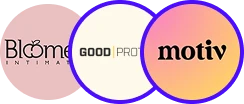
Authentic creator videos, powered by real performance data
22,000+ brands use Billo to turn UGC into high-ROAS video ads.
From Avatars to Authenticity: Navigating the 2025 Wave of AI Generated UGC
That UGC ad you just watched? The person might not [...]...
Read full articleMastering UGC Scripts: Best Practices, Templates & Creator Insight
In 2025, brands are facing the most competitive short-form video [...]...
Read full articleFrom Hashtags to Sales: UGC Campaign Examples That Worked
User-generated content (UGC) campaigns are reshaping how brands build trust and [...]...
Read full article

